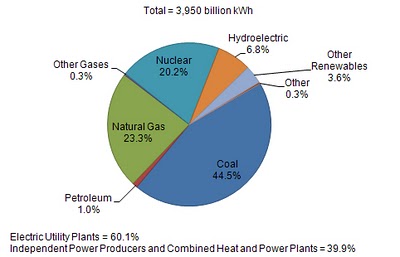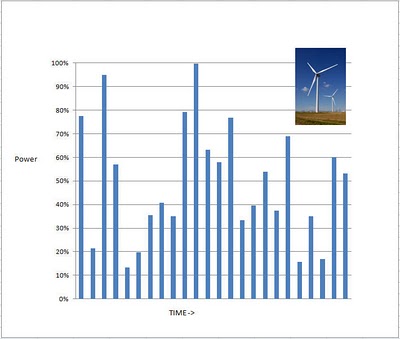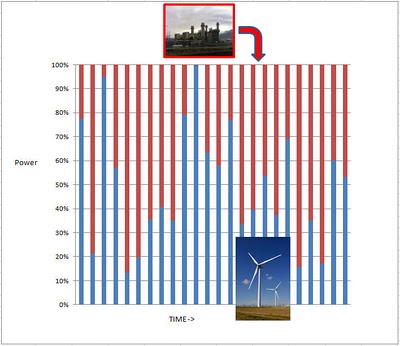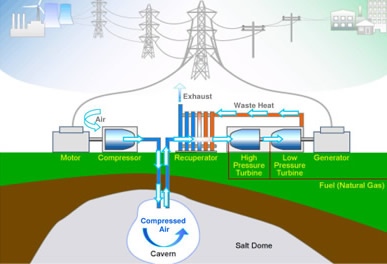Wind and Solar: Batteries Not Included
Wind and solar power have a problem in reliability. We all know the wind doesn’t blow all the time and the sun doesn’t shine 24/7, and that’s a fact of nature.
By Bill Willoughby
“Windfarm on Oahu’s north shore. As soon as we started shooting, the wind stopped.” from Jane Wells [CNBC, Hawaii]
Wind and solar power have a problem in reliability. We all know the wind doesn’t blow all the time and the sun doesn’t shine 24/7, and that’s a fact of nature. If wind and solar are to break out and become significant sources of electricity, changes are needed to improve the way we deal with that variability.
Focus on Wind and Solar
Whenever renewable energy is mentioned, wind and solar usually get the attention. Yet, wind and solar, along with biomass and geothermal, fall within the “Other Renewables” category that makes up just 3.6% of U.S. power (See Chart Below).
The reason appears partly psychological. Biomass, after all, comes down to burning a fuel; geothermal requires drilling, which makes it look like a cousin to oil and gas; and hydroelectric comes from what used to be a dirty word, dams.
The rest of the story, however, is growth. Wind and solar installations provide faster construction, are scalable, and typically don’t have the permitting battles that, in most cases, are associated with biomass or hydroelectric. Wind and solar projects also don’t carry the development risk and physical limitations that can come with geothermal power.
This ability for rapid growth is seen in wind power. In the last 5 years, the generating capacity from wind power in the U.S. has grown by about 400% to about 40 GW (See Chart Below). To put that in perspective, the total generating capacity from all nuclear plants in the U.S., 104 of them, is 101 GW.
The problem for wind is that 40 GW is generating capacity, not actual generation. Because of its variability, wind power produces less than 2% of our electricity. Nuclear power, with 101 GW in generating capacity, produces about 20%. It should be no surprise, then, that nuclear power fills a role as provider of base loads. Wind power, as it stands, does not fit well into either base load or peaking power.
Storage to the Rescue?
If wind and solar power are to reach significant levels, utilities need to be able to fill in the gaps in generation. We can think of this as adding batteries to store up energy as it is being generated for later use. We can also try to fill in the gaps by bringing in electricity from elsewhere. In the latter case, we look for improvements in transmission, deferrable loads, energy saving devices, and the Smart Grid to lead the way. As it stands now, the burden of leveling out wind and solar power lies with the sources of peaking power–hydroelectric and natural gas.?
A good overview of the approaches in physical storage can seen in the DOE’s Energy Storage Systems Conference from November, 2010. [1]
Storage systems vary in output and capacity. At the small end of the scale are actual batteries, such as lithium ion or sodium sulfide batteries, which have potential for use in households and small utilities, up to about 10 MW. Above that, at the larger scale that would support a large wind farm or solar field, three approaches appear to be emerging: 1) pumped storage; 2) compressed air energy storage, or CAES for short; and 3) molten salt.
Pumped Storage
The idea of pumping water up to a reservoir for later use is not new. There are 18 reservoirs in the U.S. that function as pumped storage, the earliest being built in the 1960’s and the most recent in 1995. Together, they have total generating capacity of 22 GW, which compares to total hydroelectric capacity in the U.S of 77 GW. [2,3]
The obstacles to new projects are high construction costs and environmental impacts. An article in NY Times [4] notes that pumped storage projects today take five years to permit, another five years to build, and cost up to $2 billion for a 1 GW facility.?
Compressed Air Energy Storage (CAES)
As anyone who owns a shop compressor knows, you can store energy in a compressed air tank too. The idea of doing it on a large scale, using an underground cavern for the storage tank, is also not new. Two large-scale CAES plants operate in the world, a 290 MW plant in Germany, built in 1978, and 110 MW plant in Alabama, built in 1991. At least 3 more plants are planned, including a 270 MW project in Iowa, a 150 MW project in New York, and another plant in Germany. [5,6]
To operate, CAES plants reheat the air in natural gas burners before generating electricity via turbines. Efficiency is a problem as about 1 unit of energy is needed from natural gas for every 2 units of energy generated. Current research is focusing on plants that don’t use natural gas for reheating, thereby eliminating the criticisms over efficiency and use of hydrocarbons.
Molten Salt
One other way of storing energy on a large scale is through heat, in this case, by melting salt. Unlike pumped storage or compressed air, storage using molten salt is more restricted by time. The process is thermal, so it’s a natural fit for solar energy using mirrors in concentrating solar plants. One being built in Arizona is the $500 million Crossroads Solar Energy Project, a 150 MW plant with 10 hours of storage time. [7,8]
The Winner Is…….
… perhaps too early to tell. In construction cost, the advantage at present goes to compressed air, at about $700/KW, versus $1,000/KW to $2,000/KW for pumped storage, and $3,300/KW for molten salt [9]. Combined with operating costs and energy losses, all three systems can cost more than what utilities are able to charge for electricity, but negative revenues for storage may be the price tag for bringing more wind and solar power onto the grid.
The idea is also out there that the balancing for more wind and solar power can be achieved through existing hydroelectric, by upgrading transmission through new power lines and Smart Grid technologies. The difficulty is this is a lot easier to talk about than actually do given the permitting and land issues that come with building new transmission lines.
In the end, the best friend to wind and solar power could turn out not to be storage or better transmission, but more local generation from natural gas, a fact that may be getting lost in the ongoing turf war between industry groups and their supporters. One thing for sure is the U.S. needs more electricity, and changes are needed to get it. How we get there depends on how the wind blows, politically and economically speaking, that is.
Help Make A Difference By Sharing These Articles On Facebook, Twitter And Elsewhere:






